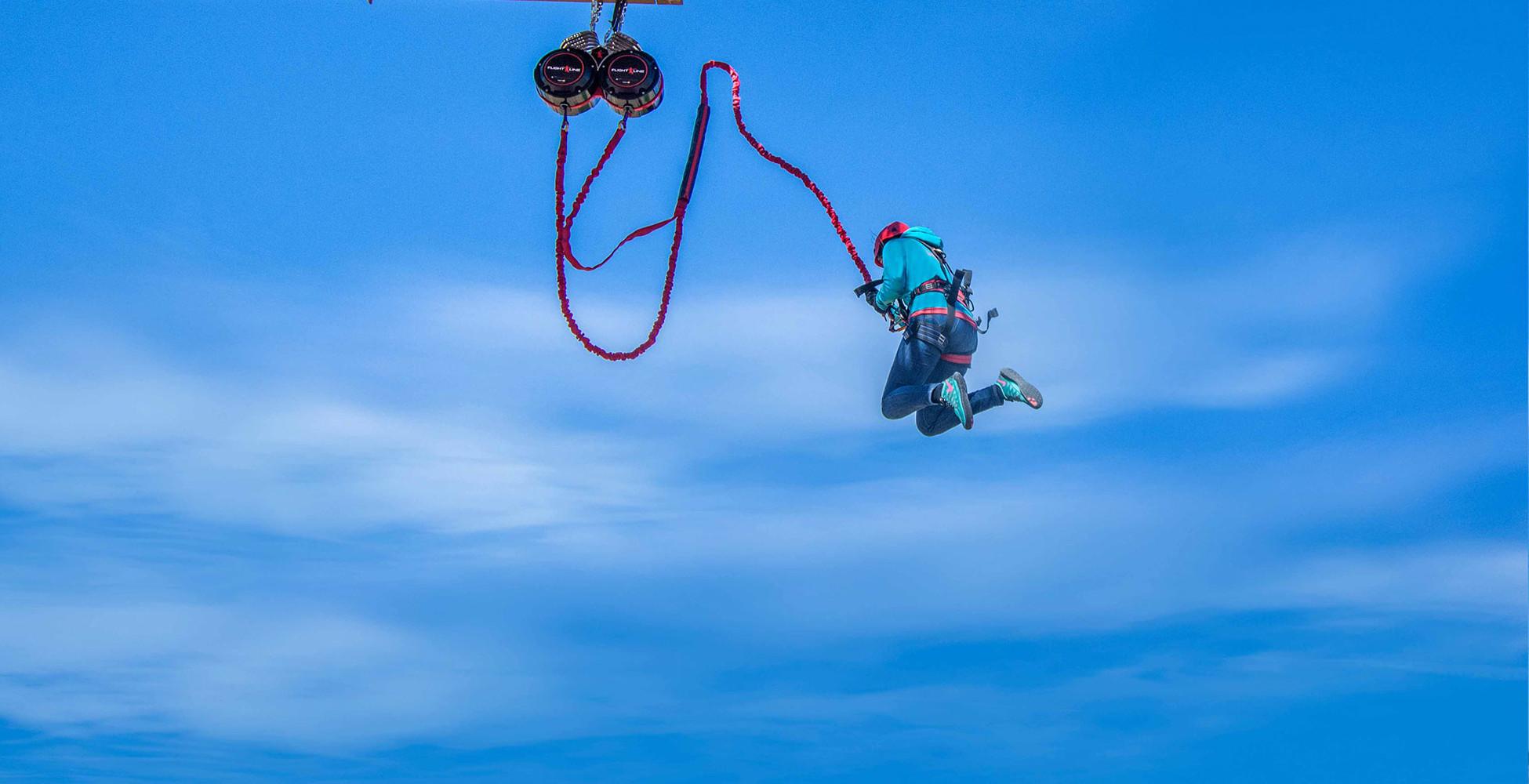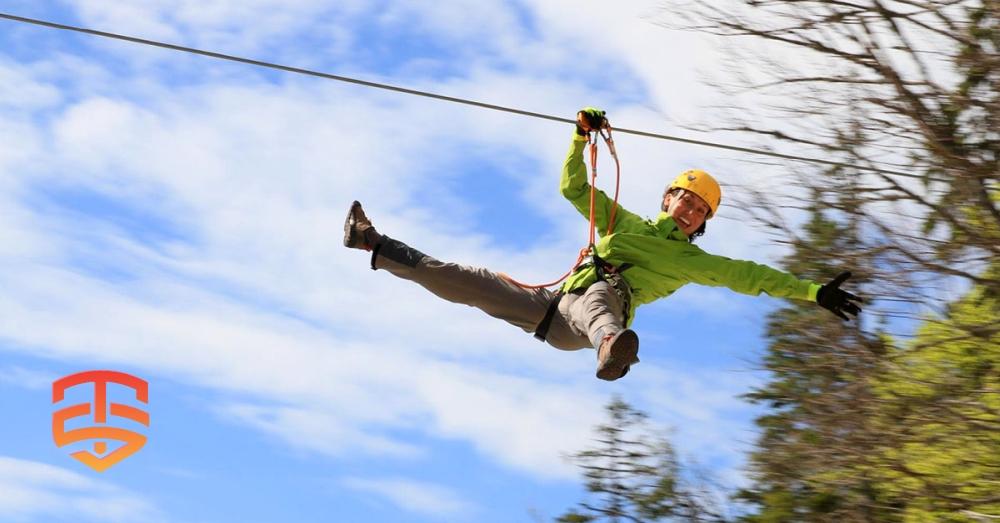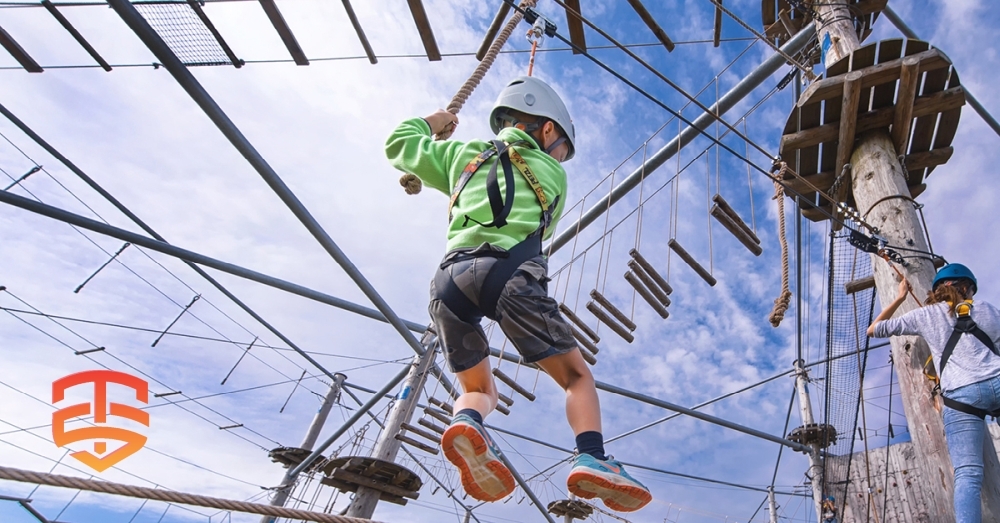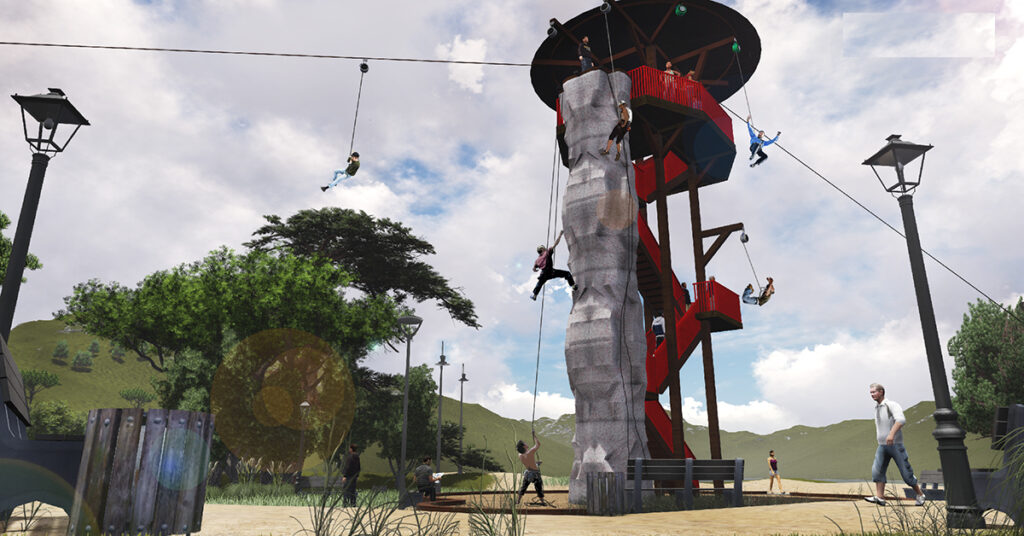
Use them right now to boost thrills while also increasing income and revenue.
This white paper examines how to boost earnings by expanding your entertainment with low expenditure. You’ll learn how to further maximize the potential of your infrastructure by changing towers and platforms from single-purpose functioning to varied revenue producers by investigating a few out-of-the-box ideas. Finally, you’ll see real-world instances of how this business strategy works and how it may help you boost customer satisfaction and results.
The challenge: platforms are designed as single-use structures
You probably already have platforms or towers in place if you’re a zip line tour, challenge course, aerial park, resort, adventure park, family entertainment center, or experiential learning institution. The issue is that many facilities perceive these platforms as one-time-use structures with limited functionality. Each structure has a distinct purpose, such as climbing, jumping, zipping, or transitioning from one action to the next.
While these platforms are undoubtedly useful in your business, they don’t actively operate to boost revenue, increase throughput, or satisfy your consumers. Building platforms for particular activities takes time, money, and reduces your facility’s overall return on investment. Turn existing platforms and towers into a new revenue stream with little effort and a quick return on your investment.
Start looking at your platforms and towers as potential revenue streams as a solution
The key to producing additional revenue from your existing platform is to think outside the box about how to make the most of it. Your current structures can enable a wide range of operations that will improve the customer experience, boost throughput capacity, and raise income possibilities.
Rather than using a separate building for each activity, try bundling numerous activities onto your existing towers to create a multi-use area that capitalizes on the potential for significant gains with low expenditure. You can leverage your current structures to enhance earnings, satisfy clients, and set your facility apart from the competition, with everything from belay-assisted rappelling to free fall thrills and leaps of faith. This white paper will go over practical ideas for raising revenue by adding more adventure and entertainment activities to your existing structures, with thrills tailored for everyone from first-timers to seasoned adrenaline junkies.
How can I improve my return on investment by adding new activities to my tower?
Your current tower is a money source just ready to be exploited. It’s simple to see why adding activities to your current towers is helpful to your bottom line, with potential to boost throughput, maximize revenue, and create delighted repeat customers.
When you add activities on your tower, you open up the possibility of accommodating more people than ever before at your business. On busy days, instead of turning people away or making them wait hours for their turn, you can utilize your tower to entertain people as they wait to engage in your primary operations (or perhaps even offer it to them as a separate option instead of what you typically offer in your main operations). When you can accommodate more people at once, you may generate more income per day from activity ticket sales as well as auxiliary things like sunscreen and photos.

There are a variety of other ways you can increase your revenue by adding additional activities to your existing towers or platforms. Ideas include:
- Charging a fee per activity, and bundling activities in order to sell more tickets
- Charging to participate in an activity as an add-on to your existing activity packages
- Renting your newly-equipped tower out to interested groups for a premium price, while still being able to run your normal operations and continue bringing in revenue.
- Groups to target could include corporate team building, bird watchers, churches, schools, and local scout groups.
- Consider creating special events to cater to these same groups, such as an early-morning weekend tour for bird watchers where participants could take time on each platform to pull out their binoculars and make notations in field notebooks before free falling, rappelling, or zipping their way back down.
Finally, by including these supplementary attractions, you may create a memorable experience for your consumers, encouraging them to return and bring their friends. Increasing the number of activities available to your consumers enhances their chances of experiencing further thrills and excitement, which encourages them to return. Repeat business is often more cost-effective than finding new consumers, so the more you can persuade people to return, the less money you’ll have to spend on marketing to keep your business growing.
Do you want to learn more about how to boost your revenue by adding activities to your existing structures? Then keep reading to find out what kinds of activities you can add to your existing platforms for little money, time, and effort.
What kind of activities can be added to my tower?
Free falling, climbing, and zip line are just a few of the activities that can be included into your location. The idea is to investigate how you might use easily available technologies in novel ways, especially when considering how numerous devices can be merged into a single adventure experience. Most platforms are just used to launch or land zip lines, however there are a plethora of other uses for your existing platform. Here are a few examples of different activities you could include in your facility:
Adding free fall elements to your tower
Many people don’t want to leap off of a perfectly excellent plane or risk the deadly recoil of bungee jumping, yet they still want to feel the rush of free fall. There are many descender options to suit both hesitant jumpers and the most daring thrill-seekers.
The carabiner(s) on a standard descender device are attached to the participant’s harness, allowing him or her to jump or step off your platform. Having a variety of free fall alternatives on your structure will let your participants to select the ideal experience for them. Consider setting up a system where participants can begin with easier, less daunting jumps before returning to the platform for more exhilarating possibilities.
When people leap for the first time, they are usually eager to do it again. Free fall activities put up in both low and high positions, with varied degrees of free fall distance, are an excellent approach to encourage people to try new jumps. A leap option can also be utilized to go down from a platform or to proceed to the next activity at your facility. This could entail arriving at a landing station and then jumping down to the next launch platform using zip lines. Regardless of the type of facility you have, at least one jumping element can usually be added to your existing tower.

Install a Free Fall Activity for Beginners:
Free fall rides using a moderate descender device or auto belay can be utilized as a stepping stone to encourage your customers to try descenders from higher heights with longer free fall distances. These first-level free falls are normally installed under 40 feet and never reach actual free-falling speed, instead providing a gradual acceleration throughout the descent. The hardest element of any free fall activity is stepping off the edge, so even your beginner-level free fall will provide clients with plenty of thrills.
Install Intermediate and Advanced Free Fall Activities: A platform rigged with a descender device with intermediate or advanced free fall heights allows your customers to have a true, exhilarating vertical free fall experience. An intermediate free fall is usually between 40 and 65 feet long, while an advanced free fall might be anywhere between 70 and 100 feet long. When your consumers step off the platform, they will experience a free fall as they accelerate with gravity’s speed. Just when they begin to worry if they’ll ever slow down, the brake slowly engages, lowering them to the ground, ready to jump again.
Include a Leap-of-Faith Element in your design:
The Leap-of-Faith is a one-of-a-kind confidence-building activity in which participants clip into an auto belay device and run off the platform. The auto belay is hooked to a trolley that is attached to a line that extends from your tower to a distant point. Your consumers drop diagonally as the auto belay traverses the line. The Leap-of-Faith is entertaining enough on its own, but you can host contests to see who can leap the farthest or set up targets to see who can land the closest to them to increase the chances of a visitor purchasing numerous descents on your Leap-of-Faith element. Leap-of-Faith is a combination of a free fall and a zip line that excels as an experiential learning or skills-building element.
Adding a climbing element to your tower is a great way to make it more interesting.
Climbing rocks is a physically and intellectually demanding sport that you can simply incorporate into your existing tower. Climbing can be a hard and enjoyable way to bring people to the top of a tall building, and it’s especially beneficial if you want to make it easy for customers to return to the top of your tower to repeat activities like zip lining or free falling.
Building a climbing wall on the side of your tower or installing a modular climbing kit on existing structural supports or surrounding trees are two options for incorporating a climbing aspect into your facility. Climbing is an activity that is suited for individuals of all ages, and routes can be made to fit anyone from the novice to the seasoned pro, making it appropriate for any of your customers, regardless of their age.
Use a Modular Climbing Kit on Existing Trees or Structural Supports:
Consider a climbing kit that you can put on the leg of your tower and neighboring trees for a less expensive and labor-intensive climbing option than a climbing wall. Ratchet straps, plates that slide onto the straps, and handholds that latch to the plates are all included in most kits. Assemble the handholds, plates, and ratchet straps, then wrap the straps around the leg of your building or the trunk of a tree to create a simple, cost-effective means for participants to return to your platform. Handhold sets of different difficulty are offered to meet the needs of customers of all climbing abilities.
You can only have one customer climb at a time using a climbing kit, unlike a climbing wall, therefore consider installing many kits on all accessible posts and surrounding trees to offer maximum participation in your climbing activities. It’s also a good idea to use an auto belay system to reduce risk and staffing requirements. You can also add a modular platform to this unique climbing feature that easily attaches to any tree or pole, allowing people to climb up to the ledge, jump off using a descender mechanism, then climb back up to do it again.
Install a Climbing Wall on One of the Tower’s Sides:
Building a modular climbing wall is a straightforward and aesthetically beautiful approach to include a climbing aspect into your current construction. There are a variety of pre-fabricated artificial walls on the market, as well as handholds of various sizes and shapes to accommodate climbers of all skills. Climbing walls are often made of wooden planks or plywood; please ask your engineer for advice on the best technique to mount a wall to the side of your project.
One of the most beneficial features of a climbing wall is that it allows multiple people to climb back up to a platform at the same time, allowing you to increase your throughput. To reduce staffing needs and reduce the danger of human mistake in belaying, we recommend outfitting each climbing lane with an auto belay system. Customers will be able to choose which activity they want to do next once they reach the top of your wall, and if you have a range of alternatives at the top, you may be able to sell several climbs to individuals as they take another ascent to try a new activity. You can increase your climbing wall’s earnings by charging additional fees per ascension.
Use Your Climbing Wall to Teach Rappelling: Your climbing wall can support high-throughput rappel stations, allowing participants to use ropes to descend the wall like a pro while being secured by an auto belay. When participants let go of their brake hand, the auto belay lowers them gradually, acting as a safety mechanism while they learn to rappel and reducing the need for professional monitoring. Charge per descent to maximize earnings once more.
Adding a zip line to your tower is a great way to make it more exciting.
Zip lines are becoming increasingly popular around the world, particularly as part of eco-tourism and adventure travel, where a zip line can provide a unique viewpoint on a rainforest canopy or a spectacular view. Zip lines are increasing higher, quicker, and longer in order to cater to explorers seeking greater thrills.
Zip lines are typically installed from one platform to another, but they can also be installed at a steep angle from one platform to the earth. To build a new zip line, your existing tower might serve as a wonderful launch or landing platform.

Install a Normal Zip Line:
Most operators have platforms dedicated to launch and landing in a standard platform-to-platform zip line. If your current platform is close to another structure, you might be able to use it as a launch or landing for a regular zip line. You might also consider flying from the platform to a distant elevation location, such as a hilltop. This would not necessitate the construction of a new platform, but it would still allow you to set up a normal zip line with little effort or expense.
Install a Steep-Angle Zip Line:
Like a conventional zip line, a steep-angle zip line launches from a platform or elevated structure, but the steep-angle drops at a 30 degree angle to the earth. If you don’t have another platform or elevated point to serve as a landing location, or if you want a truly unique offering that isn’t usually seen, the steep-angle installation is a terrific option. The steep-angle descent is a fun and unusual technique to bring people from a high point to the ground. This installation is also a fun alternative to using stairs or ladders to get your customers off your tower.
Other unique ways to use increase ROI using your existing structures
There are many other ways you can increase the revenue from your tower, and many of them don’t involve investing anything in new products or devices. Even though adding additional devices and adventure activities is a great way to increase revenue and customer satisfaction, there are myriad ways to take advantage of your existing structures, towers, or platforms. Here are some ideas, some simple and some complex, to jump-start your creativity:
- Build a small aerial park or challenge course off of a platform where customers can follow a path through various obstacles before returning to the main platform to continue their zip tour. Consider adding the aerial park as an add-on charge or as part of the tour. You could even incorporate jumping and climbing elements to add thrills to the course.
- Put a descender device on a platform and sell jumps as standalone add-ons, or build a separate pole including a climb and jump in the middle or end of a course or tour where customers could pay extra to include this feature in their experience.
- Add interesting elements between platforms or structures, such as rope bridges or swing elements. You could also include these types of elements as a route out-and- back from a main platform.
- If you have spectacular views from your platform, consider renting it out for romantic dinners or family photos. While this wouldn’t probably become a major revenue stream, it could be a unique way to get local press and set yourself apart.
- Add facilities to the bottom of your structure. Consider restrooms or a concession stand, especially mid-way through a long tour. Having snacks and beverages for sale could become a steady source of additional revenue. You could also incorporate one beverage and snack per person in the activity fee. These facilities also encourage your customers to spend more time at your tower and to enjoy more activities.
- If you have a tall structure, turn it into a viewing platform or observation deck. Allow customers to either climb up or take a ladder or staircase up to check out the views. If you don’t have a structure tall enough, make your existing structure taller if possible to allow you to offer this activity.
- Use layered platforms that allow you to incorporate jumping or rappelling and climbing. If you have a zip line tour and hike from one platform down to another, adding a jumping element would provide a more fun and exciting way to get to that next platform. Alternatively, if you have to climb up to the next platform, add a climbing wall or climbing kit and give customers the options of climbing or hiking up.
- Add photography elements to your facility. Have a photographer stationed on the most interesting platform and allow group photos of each group. You could also have a photographer follow the group through and take candid and staged photos throughout the tour. The photographer could automatically join every group or be available for an additional fee. Alternatively, consider having an automatic photo at a few particularly interesting locations throughout your tour. Customers could then buy the photos in the lobby after their activity ends.
- Another option for descending is building a slide. Allow participants to slide down, and then either climb or hike back up to the platform for the next activity.
Conclusion
Remember that there are various methods to utilize that area, drive income, and ensure happy, repeat clients, regardless of how you choose to use your existing platform, structure, or tower. While each facility will approach this differently depending on their setup, nearly everyone can benefit from adding activities and adventure with simple-to-install, high-return devices like our TRUBLUE Auto Belay, Arboreal Climbing System, QUICKflight Free Fall Device, zipSTOP Zip Line Brake, or FlightLine Commercial Descent Device. Your biggest asset in developing methods to transform existing structures into high-performing multi-use areas is your imagination.
Consider the new Adventure Tower if you want to make the most of your facilities but don’t have the time or energy to do it yourself. The Adventure Tower, a highly adaptable structure that can accommodate various adventure activities in a vertical space, may be precisely what you need to boost your bottom line and establish your facility as the best in your region.







